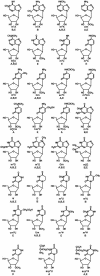The Small Subunit rRNA Modification Database
- PMID: 15608163
- PMCID: PMC539969
- DOI: 10.1093/nar/gki015
The Small Subunit rRNA Modification Database
Abstract
The Small Subunit rRNA Modification Database provides a listing of reported post-transcriptionally modified nucleosides and sequence sites in small subunit rRNAs from bacteria, archaea and eukarya. Data are compiled from reports of full or partial rRNA sequences, including RNase T1 oligonucleotide catalogs reported in earlier literature in studies of phylogenetic relatedness. Options for data presentation include full sequence maps, some of which have been assembled by database curators with the aid of contemporary gene sequence data, and tabular forms organized by source organism or chemical identity of the modification. A total of 32 rRNA sequence alignments are provided, annotated with sites of modification and chemical identities of modifications if known, with provision for scrolling full sequences or user-dictated subsequences for comparative viewing for organisms of interest. The database can be accessed through the World Wide Web at http://medlib.med.utah.edu/SSUmods.
Figures

References
-
- Littlefield J.W. and Dunn,D.B. (1958) Natural occurrence of thymine and three methylated adenine bases in several ribonucleic acids. Nature, 181, 254–255. - PubMed
-
- Smith J.D. and Dunn,D.B. (1959) An additional sugar component of ribonucleic acids. Biochim. Biophys. Acta, 31, 573–575. - PubMed
-
- Fox G.E., Pechman,K.R. and Woese,C.R. (1977) Comparative cataloguing of 16S ribosomal RNA: molecular approach to prokaryotic systematics. Int. J. Syst. Bacteriol., 27, 44–57.
-
- Grosjean H. and Benne,R. (eds) (1998) Modification and Editing of RNA. ASM Press, Washington, DC.
-
- Wimberly B.T., Brodersen,D.E., Clemons,W.M.,Jr, Morgan-Warren,R.J., Carter,A.P., Vonrhein,C., Hartsch,T. and Ramakrishnan,V. (2000) Structure of the 30S ribosomal subunit. Nature, 407, 327–339. - PubMed
Publication types
MeSH terms
Substances
Grants and funding
LinkOut - more resources
Full Text Sources
Other Literature Sources

